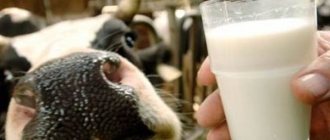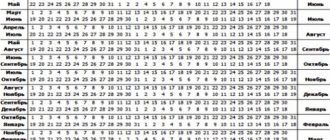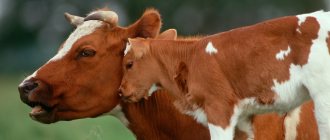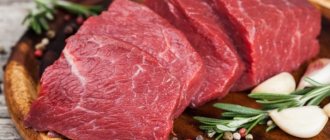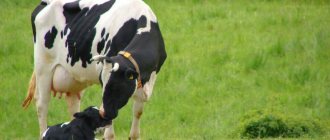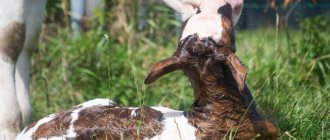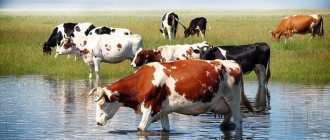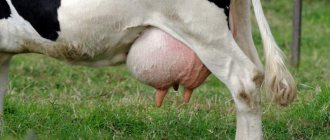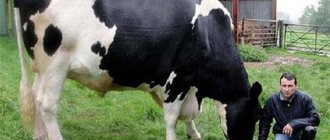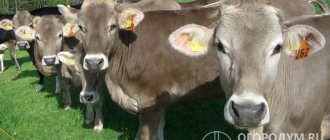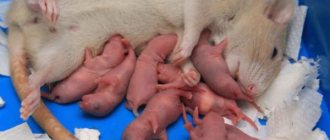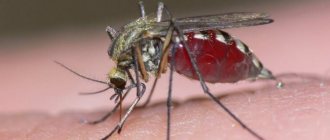Maintaining high milk yields and ensuring an increase in the herd population is impossible without the period of pregnancy and childbirth of the cow. Experienced breeders know very well how these processes take place, and they do not raise questions about them. For a novice farmer, breeding cows raises many questions when he is faced with the difficulties associated with the pregnancy period. Without knowing the basics about this process and without an idea of how long a cow carries a calf, it is impossible to provide the animal with the necessary care and prepare in a timely manner for the birth of offspring.
Pregnant cow
During the period of bearing a calf, serious changes occur in the cow’s body that must be taken into account. If you do not take them into account during pregnancy, nothing good will come of it. Problems with pregnancy and calving are most often caused by the inexperience of the owner, who incorrectly and untimely transfers the cow to dry land and makes mistakes in starting her up. Before starting a cow, you need to find out exactly what the animal will need in the future.
Types of insemination
This can be done in two ways:
- artificial;
- and natural.
Artificial is preferable. Since then
- eliminates the possibility of infection with various cattle diseases,
- and there is an opportunity to use higher quality sperm from productive bulls.
It is better to impregnate a cow during the second or third heat. This
- increases the chances of the event being successful;
- and increases the duration of lactation in the future.
It is advisable to inseminate twice (the second after twelve hours). This makes it more likely to achieve results.
Is the cow ambulating or not - calculating the estimated calving day (APD)
First, let's decide how to correctly calculate the pregnancy period of your cow.
Here is my working formula for calculation: date of coverage (insemination, fertilization) + 9 months. On the same date, after 9 months, the cow should give birth - this is the estimated calving date .
Example(!): If I inseminated a cow on August 20, then the expected calving date (CAD) is May 20. Sometimes my charges calve 2-3 days before PDO, sometimes 15-17 days later (the normal pregnancy period is from 270 to 290 days). This is absolutely normal.
Duration of pregnancy (pregnancy)
How long a cow's pregnancy lasts depends on a number of factors. The duration of pregnancy varies quite a lot. The average gestation period for a cow is 285 days. Deviations from this period may be large. Calving on day 311 or day 240 is not considered pathological. Cases when a cow takes too long are not common. The number of out-and-out heifers usually does not exceed 10%. Early birth is observed in 4-6%.
Hormonal disorders in the body and the slow formation of the calf due to the individual characteristics of the female can extend the gestation period.
Early calving occurs in cases where the cow has had poor, illiterate care, she experiences a slight deficiency of vitamins and minerals in the body, or suffers from stress. Large calves are also born earlier. When the fetus is small, birth is usually observed closer to the 300th day of gestation. Pregnancy longer than 311 days is pathological and requires veterinary intervention.
The average gestation period for a cow is 285 days.
If the birth of a calf occurs before the 140th day, it is not viable and we are talking about a miscarriage. Many factors can provoke it. Most often, miscarriage in a cow is caused by the following reasons:
- Poor content;
- Diseases of the reproductive system;
- Improper examination - especially rectal and manual;
- Ultrasound too early - before 1 month of pregnancy;
- Strong physical activity - driving a pregnant heifer to distant pastures.
A miscarriage can also occur in a cow in the event of sudden hormonal fluctuations. They can occur during rapid weather changes or when the animal is given a number of medications that are contraindicated in pregnant females (when pregnancy has not yet been detected, due to the short period).
Pregnant cow
Knowing how long a cow carries, it is possible to calculate the approximate date of calving and qualitatively prepare for it. It is necessary to agree in advance with an experienced veterinarian so that, if necessary, he can urgently arrive and provide assistance to the animal.
About a pregnant cow
Before pregnancy occurs, the cow's health changes cyclically. She keeps repeating the following:
- estrus occurs first;
- then the state of hunting sets in;
- after this ovulation occurs.
The duration of such a cycle may vary at different times. It usually ranges from 19 to 27 days. When mating occurs during ovulation, the cow becomes pregnant.
Once the animal is impregnated, it is recommended that the farmer calculate the dates of how long the pregnant cow walks and create a calendar of how the pregnancy will progress. This is necessary in order to properly care and ensure the appearance of healthy offspring. If you ask the question of how many calves a cow can give birth to at one time, then the maximum number is two calves.
Two calves
Rules for calculating gestational age
Determining the gestational age of a pet is not difficult. Uncontrolled insemination for cows is almost never practiced, as it is extremely inconvenient. For this reason, the owner always knows the date when the cow was covered. Thus, the deadline for a specific day is always known. In order to find out the approximate calving date, you do not need to sit with a calendar and count down the days.
There is a simple scheme for calculation. It looks like this: D = (H + 10): No. - 3. The formula is deciphered as follows:
- D—calculated calving date;
- N - number of mating or artificial insemination;
- No. is the month in which insemination took place.
H + 10 is the calving number. If, when adding the mating day with 10, the sum is greater than 30, 30 is subtracted from it. On the contrary, 1 is added to the month number. If the mating month has a number from 1 to 3, 12 must be added to it.
Knowing the mating date, you can calculate the calving date
It is most convenient to keep a pregnancy calendar for cows. It allows you to avoid confusion and timely transfer the cow to dry land and start it, and also not to forget the necessary dates.
Changes that occur in a cow's body during pregnancy
In pregnant cows, as the fetus develops, intraperitoneal pressure increases, which in turn causes increased frequency of defecation and urination, and breathing becomes increasingly chesty and rapid. Kidney activity increases. In the second half of pregnancy, protein is often found in the urine. An increased load on the cardiovascular system causes hypertrophy of the heart muscle, mainly the left ventricle (pregnant hypertrophy); the functional state of the myocardium and vascular tone increases.
As a result of the development of placental blood circulation, the vessels of the uterus grow, their diameter increases by 4-5 times. The amount of blood increases by 20-25%, but its morphological composition remains almost unchanged. Young forms of red blood cells appear in the blood. Fluctuations in hemoglobin levels in the blood remain within normal limits. There is an increase in blood clotting. The erythrocyte sedimentation reaction accelerates. The amount of calcium and phosphorus in the blood decreases, potassium increases. Physiological “acidosis of pregnancy” is observed. The amount of total protein and the viscosity of the blood serum are slightly reduced. The content of calcium, phosphorus (calcium-phosphorus ratio), carotene, alkaline blood reserve varies depending on the season of the year and the composition of the diet.
There is a strong change in metabolism. Initially, as a result of increased appetite and digestibility of feed, body condition improves; by the end of pregnancy, cows lose weight, and if fed and maintained improperly, they may become emaciated. Fluctuations in metabolic rate cause uneven growth of the cow's horns and hooves, and rings form on them.
Cows often experience disturbances in mineral metabolism. If there is no mineral supplement in the diet, the cow's bone tissue is depleted of calcium salts (osteomalacia in cows and goats), which predisposes to bone fractures. Violation of mineral metabolism greatly affects the condition of the teeth (change of teeth in cows). Water metabolism is closely related to mineral metabolism. Studies have shown that during pregnancy, tissues in cows retain water, become more juicy, and are prone to edema.
Pregnancy in a cow is accompanied by the accumulation of nitrogenous substances in the body. The urine contains less urea, the amount of ammonia and other products of incomplete combustion of proteins increases.
The absorption of feed carbohydrates is improved. Glycogen accumulates in the liver.
Changes in fat metabolism are expressed in an increase in the amount of neutral fats, lipoids and cholesterol in the blood.
As pregnancy progresses, significant amounts of hormones (placental) are formed and accumulated in the body. Pregnant cows produce melanogormon, which causes pigmentation of the placenta and the appearance of “pregnancy spots” visible on non-pigmented skin, especially in the mammary gland area.
Strong changes occur in the genitals. With pregnancy, the corpus luteum of pregnancy appears in the ovaries. Follicle development does not stop, but ovulation and estrus usually do not occur.
In some cows in the fifth month of pregnancy, threads of viscous transparent mucus are released from the genital slit for several days due to liquefaction of the mucous plug of pregnancy in the cervix . On farms, as well as among owners of private household plots and peasant farms where timely diagnosis of pregnancy is not practiced, this is regarded as a sign of estrus, artificial insemination (insemination of animals) is used and often causes abortion.
With the development of the embryo, impulses emanate from it, causing an even more profound restructuring of the uterus. The uterus increases in size and weight (20 times compared to the non-pregnant state). This growth is a consequence of hypertrophy and hyperplasia of muscle fibers in the first half of pregnancy and stretching of the uterus in the second.
The length of individual muscle fibers of the pregnant uterus can reach 500 microns (in the non-pregnant uterus it is only 40-50 microns). In the first half of pregnancy, the wall of the uterus is juicy and thickened (due to the development of the mucous and muscular membranes). Towards the end of pregnancy, as the overall size of the uterus increases, its wall, which can stretch greatly, becomes thinner. The uterus changes especially significantly in the horn of the fetus. Here, in the mucous membrane, the maternal part of the placenta (new structure) is formed. During a singleton pregnancy, a cow experiences a strong enlargement of the horn, which serves as a receptacle for the fetus. The free horn also increases, but it is always 2-5 times smaller than the fruit-bearing horn.
In a singleton pregnancy, the right horn serves predominantly as the receptacle for the fetus. In multiple pregnancies, the fetuses are usually located in both horns.
The wide uterine ligaments are stretched. In their thickness, the number of smooth muscle fibers increases. The lumens of the vessels running along the ligaments and located in the wall of the uterus expand 4-5 times or more. Simultaneously with the enlargement of existing blood vessels, additional vascularization of tissue occurs. The amount of blood passing through the middle uterine arteries increases.
The cervix increases in volume, its mucous membrane hypertrophies, and the canal closes tightly. Its lumen is closed by a thick elastic translucent mucous plug, slightly protruding from the outer mouth of the cervix into the lumen of the vagina. The vaginal mucosa is pale, congestively hyperemic towards the end of pregnancy, sometimes somewhat swollen.
How long can a cow walk?
As soon as fertilization of the cow has occurred, the farmer is obliged to create a special cow pregnancy calendar. It will help you navigate the timing and determine the approach of calving. This document is used in all large farms. If a cow is nursing, then using the calendar it is easy to understand how many days she carried the calf.
It is considered normal if the animal walks for 10-15 days, because when determining the onset of conception, an error is possible. However, if calving does not occur at a later date, then there is a reason to contact a veterinarian. He must make sure that everything is in order with the heifer and the fetus in her womb.
Reference. In some cases, a cow can walk for more than three weeks. A veterinary examination is necessary in every case of delay in calving by more than 3 weeks to exclude fetal death and mummification.
"Tramped" calf
It is considered normal if the animal walks for 10-15 days, because when determining the onset of conception, an error is possible. However, if calving does not occur at a later date, then there is a reason to contact a veterinarian. He must make sure that everything is in order with the heifer and the fetus in her womb.
Reference. In some cases, a cow can walk for more than three weeks. A veterinary examination is necessary in every case of delay in calving by more than 3 weeks to exclude fetal death and mummification.
Post-calving care
Behind the calf
After birth, the calf is placed on a piece of clean burlap. Immediately wipe his nose, eyes and ears from mucus with sterile cotton wool, and then wipe him completely with a diaper or towel.
The umbilical cord is broken off by hand at a distance of 10 cm from the abdomen. Blood is squeezed out from the remainder of the cord and it is treated with iodine.
The baby is then carried on a burlap sack to the mother's head so she can lick it. You should not take a calf from a cow.
If the cow refuses to lick the baby, it is taken to a warm room to dry.
In this case, you will most likely have to feed him from a nipple. If the calf is born very weak, it is kept separately from its mother.
In the first week, the calf will feed on colostrum, which is produced by the mother.
The first feeding should occur no later than 45 minutes after the baby is born. From the second week he is switched to mash, and from the 3rd week the gradual introduction of straw and fruit into the diet begins.
If the cow is a firstborn, then it can be aggressive towards the offspring.
In such a situation, the calf will need to be kept separate from her, with colostrum milked for it. You will also have to separate the weak calf from the twins so that it can receive enough feed.
Advice! You can let the calf out to graze from the age of one month, when it is already able to eat grass on its own.
Behind the cow
You should not overfeed a cow after calving. The portion of food should be 70% of the standard volume, which is returned to only a week after the birth of the offspring.
The cow must be taken out to pasture so that she can eat herbs that will help her recover faster. Feed is given at the same time.
An hour after calving, the cow should be given salted water to drink. It is prepared at the rate of 150 g of salt per 10 liters of water. This drink speeds up the animal’s recovery process.
The first milking, after the cow has calved, takes place 2 hours later. She will not produce milk, but colostrum, which is intended for the calf.
Before milking, the rear part of the cow is massaged. The udder is washed with a weak solution of manganese. An udder massage is also required.
In the event that a cow suffers from mastitis that developed even before calving, she must be milked immediately after giving birth.
The resulting colostrum is destroyed because it is contaminated and cannot be given to the calf.
The first week you should milk up to 5 times a day, and the night break should not be more than 10 hours. Milking is carried out at the same time.
The volume of milk produced by a first-calf heifer depends on its breed. The indicator can range from 6 liters to 15 liters. Meat breeds have milk productivity significantly lower than dairy breeds.
Transferring the cow to dry stand
The dry period is the time period before calving, when the cow is resting and gaining strength for lactation. At this time, her milk yield decreases, and milk production gradually stops. However, it is important to correctly transfer the animal to dry wood. To do this, you need to know exactly how far into pregnancy the cow is , because the heifer needs about 60-70 days to rest before calving.
To transfer an animal to dry wood, various methods are used:
- Approximately 70 days before the expected calving date, the cow's diet is changed.
- Reduce the number of milkings per day.
- Milking is done at a different time, unusual for the cow.
Power at startup
To reduce milk production, it is necessary to remove succulent food from the animal’s diet. They are replaced with hay. Concentrates are also excluded for a while. In the warm season, when the heifer is grazing on pasture, they stop feeding her with green mass and concentrated feed. If milk yield does not decrease, it is recommended to leave only roughage in the diet. During the stall period, it is permissible to introduce flax cake, oatmeal, and wheat bran into the Burenki menu.
Reducing the number of milkings
Changes in the milk expression schedule lead to disruption of conditioned reflexes. The nervous system of the cow reacts to such changes by reducing milk yield. Sometimes it is enough to change the usual mode of pumping, as milk production is noticeably reduced. Many farmers use this technique very successfully. In some cases, it is not even necessary to change the diet of a pregnant cow.
Attention! When starting, you need to be more attentive to the udder. At this time, there is a high probability of developing stagnant processes, mastitis.
Once the milk stops coming in, which usually takes about 7-12 days, the cow's diet should be adjusted to include all the necessary vitamins, minerals and trace elements. The last two months of pregnancy are very important - during this time the calf gains weight and develops very rapidly. Lack of nutrients can lead to various health pathologies.
What kind of discharge does a cow have before calving?
Normal before calving
of
the cow's
genital tract, which lubricates the birth canal. This is necessary for comfortable advancement of the fetus. Important! There is a lot of discharge, it is transparent and has a thick consistency.
Interesting materials:
What fertilizers reduce soil acidity? What fertilizers are applied to sandy soil? What fertilizers acidify the soil? What threats to soil exist today? What conditions can lead to soil failure? What substances can be used to deoxidize soils? What substances are used in spring to deoxidize the soil? What types of soil erosion are there? What types of soil erosion do you know? What are the types of soil erosion?
Care and feeding of pregnant cows
Proper care and balanced feeding of a pregnant cow will ensure a healthy offspring, high-quality lactation and the required amount of milk. Let's look at the features of care and start with preliminary preparation for calving.
The basis of this preparation is proper care of the pregnant animal. It is necessary to provide good conditions and feeding enriched with the necessary vitamins and minerals.
The time a cow spends on pasture is reduced to avoid excessive consumption of succulent feed, but she must be in the fresh air, since being outside is beneficial:
- Thanks to the normal supply of oxygen, blood circulation throughout the body improves.
- By walking, the animal improves its muscles and strengthens the vestibular apparatus, which is very necessary before calving.
- Summer “exercise” saturates the body with calciferol, which is important for strengthening the bones of the pregnant heifer and fetus.
During the dry period (at the end of lactation and before new calving), feeding should be carried out according to a schedule, following a certain diet with an increased amount of proteins, vitamins, minerals and fats that affect lactation and milk. Temperature conditions, good ventilation and drinking at the right time are also important.
Below is an approximate diet for a pregnant dry cow with a live weight of 500 kg, an estimated milk yield of 4000 kg of milk with 4% fat:
| Stern | Quantity (kg) | They contain | ||||
| Feed units | Digestive ( g) | Calcium (g) | Phosphorus (g) | Carotene (mg) | ||
| Silage | 15 | 3,00 | 210 | 23 | 83 | 225 |
| Meadow hay | 6 | 2,52 | 288 | 36 | 13 | 90 |
| Spring straw | 2 | 0,62 | 28 | 8 | 2 | 3 |
| Sunflower cake | 0,7 | 0,77 | 277 | 3 | 7 | 1 |
| Wheat bran | 1,5 | 0,10 | 195 | 2 | 15 | 6 |
| Feed precipitate | 0,10 | — | — | 26 | 17 | — |
| Pine flour | 1 | — | — | — | — | 80 |
| TotalRequired by standard | 8,01 | 998 | 98 | 62 | 405 | |
| 8,00 | 960 | 90 | 60 | 400 | ||
During development, the fetus needs large quantities of minerals and vitamins. As the period increases, the fetus also grows, therefore, it requires more and more intrauterine nutrition.
Feeding a cow before calving
10–15 days before the possible calving date, the cow is switched to food made from high-quality hay from cereals, and concentrated food is removed from the diet altogether or left in an amount of no more than a kilogram per day. Also, succulent foods are excluded from the diet - there is already too much fluid in the body.
Don’t forget about the dosage of microelements, for example, you need 9–10 g of calcium per day, and 7–8 g of phosphorus.
On the eve of calving, the feed ration is prepared according to the following scheme:
- Silage and cereal hay - 60%.
- Concentrated feed - 24%.
- Roughage - 16%.
This is the optimal feed ratio before calving. Speaking about the daily requirement before calving, we note that a cow needs about 10 kg of hay. If for some reason it is not possible to give so much, they give less, but add vitamin preparations on the recommendation of a veterinarian. Feeding is done three times a day, and watering is also done three times, only with filtered or boiled water at a temperature of 8–10 °C. In addition to the recommended food, be sure to give from 30 to 50 g of salt and chalk.
During the first dry period (60–20 days before calving), the diet must be saturated with fiber and only high-quality fresh food without spoilage and mold should be given. Particular attention should be paid to the animal’s body weight - it should remain unchanged; if necessary, the diet should be supplemented with nutritious feed.
Important! During the dry period, alfalfa and molasses are not allowed in the cow’s diet!
During the second dry period, the cow’s diet does not change much, only closer to calving, more fiber and vitamins are added to compensate for the cow’s energy deficiency.
Feeding immediately before calving
Three weeks before calving, to improve the quality and quantity of milk, feeding is carried out according to the following scheme:
- 21–14 days before calving, a transition to feeding three times a day is carried out, with every 2 kg of main feed diluted with 1 kg of a concentrated mixture.
- 14 days before the appearance of the offspring, 2 kg of main food are given three times a day, and in addition, 1 kg of concentrate is added to the morning and evening feeding, and 2 kg to the daytime feeding.
- During the final week - 2 kg of main food and 2 kg of concentrate at each feeding.
Separately, it should be noted the peculiarities of feeding a pregnant cow in winter. During this period, the diet must be enriched with nutritional supplements and vitamins. Such additives include fish oil, feed yeast and special vitamins. The diet should also include bran and cake.
The winter shortage of certain substances is compensated by the animal’s free access to table salt and branches of coniferous trees (preferably pine).
Did you know? In one minute, a cow makes about 100 movements with its jaw.
One week before calving
A week before the expected calving, the cow needs constant monitoring, since it is impossible to accurately determine the day on which calving will occur.
The owner must also fully equip the stall in which the cow will give birth and subsequently stay with the calf.
It is advisable to carry out such preparation in advance, a month before the expected calving, so as not to encounter a problem if it happens early.
Feeding a week before giving birth requires special care. Nutrition needs to be balanced. Feeding with hay alone is stopped as soon as lactation stops.
In order to understand how well a cow is eating, it is weighed.
She should gain about 65 kg in the week before calving. If more than 75 kg of weight is gained, this means that the animal is overfed, which will negatively affect the process of giving birth to a calf.
Underweight, when its gain is less than 50 kg, indicates a decreased appetite of the cow or inadequate quality of feed. Insufficient weight gain in a pregnant cow negatively affects the condition of the calf.
A week before the expected calving, you should wash the cow with warm water and treat its hooves with a solution of creolin with a strength of 2%. The animal must be kept as clean as possible.
Help for a woman in labor
To assist a giving birth cow, a person is tied with a rope around the waist and tied to the emerging legs of the calf. They do this in the case when they know how long a cow carries a calf, and the birth has come, but the fetus does not come out for a long time so that it does not suffocate. A man, resting his back on the cow, helps in childbirth.
If there can be two people during childbirth, then everything will go easier. They wrap straw (a rag) around the legs (front) of the calf and help it come out into the light. To do this, the calf is carefully pulled out. Sometimes, extremely rarely, a cow needs to have a caesarean section. But this operation is performed by a veterinarian.
Complications during childbirth occur in young cows, whose owners do not yet clearly understand how long the cow’s pregnancy lasts, and she is carrying a calf for the first time (first heifer). Such young women in labor, pregnant for the first time, require special attention and care. As a rule, they receive vitamins and improved food.
But there is also one peculiarity here: you cannot allow the cow to become overly fat. Of course, you need to keep an eye on the cow at night, because this is quite a favorable time for giving birth. A pregnant cow in a stall runs the risk of dying or losing her calf during birth if she stands close to the wall.
How to determine pregnancy
It is quite difficult to determine that a cow is pregnant in the early stages.
However, there are a number of signs by which you can determine that a heifer is carrying a calf:
- changes in behavior - the animal becomes calmer;
- changes in diet - appetite increases several times;
- changes in appearance - the coat becomes smoother, shine appears;
- Due to hormonal changes, mucus discharge appears on the genitals.
Only a veterinarian or a very experienced farmer can determine pregnancy by examining the rectum.
The birth process
Thanks to the calendar, the farmer knows approximately how long a cow is carrying a calf; this document helps to prepare in time for its birth. The first step is to take care of arranging the calving area. What measures need to be taken before this important event:
- Clear the stall.
- Make sure you have clean soft hay bedding.
- Treat manure grooves with lime solution.
- Disinfect the cow's hooves using a creolin solution at a concentration of 2%.
Recommendation. There should be no dampness or draft in the place intended for calving and for the cow and calf to stay there. It is worth taking care of good lighting.
Dry period during pregnancy
The dry period begins at 7.5 months after fertilization of the heifer. Pregnant cows are placed in boxes. I write the date on the calendar. The boxes are kept clean and temperature controlled. The animal lies down a lot during this period. Dead wood does not mean insulation. The cow is still walked, but no more than 1-2 hours in the cool season, and 4-5 hours in the warm season. They don't take milk from her anymore. To ensure that the calving process proceeds without complications and that the calf develops normally, the pregnant cow’s diet is changed during the dry period.
For meat productivity cows, the following diet is maintained:
- hay from cereals and legumes - 4 kg;
- juicy haylage - 4 kg;
- silage, preferably corn - 12 kg;
- concentrated feed - 1.5 kg;
- table salt - 50 g.
In addition to the basic diet, cows are given supplements with vitamins, microelements and proteins. She should receive 700 g of protein and carotene per day, and the same amount of starch. Mineral supplements consist of salts of phosphorus, calcium, copper, cobalt. Their quantity is 100 mg. Increase feed containing zinc to 500 mg
Dairy cows have a slightly different diet:
- they receive more hay and haylage, up to 7 kg.
- amount of dry food - 2.5 kg.
- salt - up to 70 g.
- silage - 12 kg.
They require more protein and mineral supplements, starch and carotene. Animals are beginning to be limited in water, no more than 48-50 liters per day. Feeding is carried out 3 times a day. Pregnant cows are not given pulp, stillage and yeast nutritional supplements. Limit in feed, which contributes to increased gas formation. 10 days before the expected calving, the diet rate is reduced by 20%.
All feed must be of the highest quality. Moldy haylage or frozen silage is not allowed. This can cause premature labor.
Experts recommend adhering to nutritional standards. Underfeeding will not make calving easier. Over the past 2 months, the calf has been rapidly gaining weight and developing rapidly. Excessively increased nutrition will complicate calving and the loss of the placenta. A pregnant cow needs to move. She is walked every day.
Signs of approaching calving
Shortly before giving birth, the cow begins to behave restlessly. She feels discomfort, so it is easy for a farmer to determine the approach of labor by the following signs:
- The chick looks back, shifts from foot to foot.
- She's shy.
- The animal eats significantly less and drinks little.
- The external genitalia are slightly enlarged.
- A mucous secretion is released from the vagina.
- The udder swells and colostrum begins to drip.
- A few hours before giving birth, the cow twitches its skin.
- In summer, the animal may separate from the herd and try to hide in the bushes.
- The sacrum descends.
- The pelvic ligaments relax.
- The cow lies for a long time and moos.
A sure sign of the onset of labor is that the cow lies on her side (usually the left). At this time, it is necessary to prepare everything that may be needed at the hotel - towels, warm water, soap, a solution of potassium permanganate at a concentration of 1%, iodine solution (5%), scissors.
Signs of approaching calving
How much milk does a cow give per day?
You can control the approach of the calving date using various methods:
- One of them is that you can simply take the cow's milk to a veterinary laboratory for analysis. It makes sense to do this no earlier than the twentieth day after mating occurs. After analyzing the composition of the milk, experts will give an opinion on whether there is a pregnancy and whether calving will occur soon.
- One of the signs is the presence or absence of a hunting condition in this cow. If a bull is brought to her, her reaction in a state of pregnancy will be neutral, while under other circumstances things will be different.
- When the fifth month of pregnancy begins, the presence of a fetus can be visually determined. In this case, it is enough to carefully touch the cow to make sure of this. However, this must be done very carefully.
- There is a popular way of determining. To do this, you will need to prepare a glass of clean water. Then you need to take milk from the cow. It is necessary to use not the one that spills in the first streams, but the one that comes next. You will need to drop it into a glass of water. In this case, the drops of a pregnant cow will not mix with water at all and will immediately fall to the bottom. Otherwise, the milk will dissolve.
Folk way to determine if a cow is pregnant
There is a method that will be called rectal. When using it, you need to be especially careful not to damage the cattle fetus. It can be used no earlier than two months after insemination occurs. An assistant will be required when performing this inspection. During the procedure, his role is to hold the cow by the horns. If the cow continues to behave unpredictably and restlessly, then you need to squeeze her nasal septum with your fingers. Before the examination, fingernails must be cut and hands must be thoroughly washed. Immediately before the examination, hands are thoroughly lubricated with Vaseline. The hand must be placed inside the anus and move deeper until the uterus can be felt. Then the cervix is determined, then you need to lightly touch the ovaries.
If there is no pregnancy, the following can be seen by palpation:
- The uterus is located inside the pelvic cavity.
- She has the same horns, the same as the groove.
- If you gently feel it, it will contract.
- The ovaries are located to the left and right of the uterus.
Cow pregnancy
If pregnancy is present, its duration can be determined as follows:
- At a monthly period, one horn will be larger than the other.
- The one with the embryo will be slightly flabby.
- The contractions occurring in the uterus are felt a little weaker.
- The corpus luteum is still present in the ovary.
When two months have passed since fertilization, the signs become more distinct and can be considered as definitive proof of pregnancy.
When examined during this period of time, you can find that:
- The horn that contains the embryo is twice the size of the other.
- The tip of it penetrated into the abdominal cavity.
- The interhorn groove is clearly visible to the touch.
This way you can more accurately determine how long a cow carries a calf.
Features of lactation
A cow produces milk only when she needs to feed her offspring. That's why
- so that she gives milk, insemination is carried out annually;
- In first-calf heifers, milk begins to be produced only after birth;
- in adults it may appear before calving;
- during the first ten days they produce colostrum (fat milk enriched with all the necessary nutrients for feeding calves);
- lactation lasts from nine to eleven months in dairy breeds, and seven to nine months in meat breeds.
Possible complications
After calving, the cow may develop complications that will require mandatory treatment. It is necessary to involve a veterinarian.
Few and only very experienced livestock breeders can independently restore the normal condition of a cow.
Knowing exactly how to deliver a cow at home helps reduce the risk of complications.
The cow doesn't get up
A cow may not get up after calving for several reasons. To determine exactly what kind of disorder is occurring, you should try to lift the animal.
If there is no paralysis and the cow stands up when forced but the hindquarters are drooping, there is likely damage to the sciatic nerve plexus at the sacrum.
The most severe complication that occurs after calving is paresis, in which the cow does not stand up, but for a short time becomes paralyzed and may lose consciousness.
This complication is most likely in heavy animals of highly productive breeds. If treatment is started in a timely manner, the outcome for the cow is usually positive.
The cow was not cleansed
A retained placenta is diagnosed if it does not come out within 8 hours. Within a day, it will begin to rot in the cow’s body, poisoning the entire body.
If there is a delay, forced separation and removal of the placenta is necessary, which is carried out by a veterinarian. The condition of the cow will require special monitoring.
Udder swelling in a cow
Udder swelling after calving can occur for many reasons.
The problem can be caused by infection of the mammary glands during the first milking, poor nutrition when there is too much fluid in the animal’s body, as well as injury.
The specific cause is determined after examining the cow and assessing its diet.
To solve the problem, you should definitely consult a veterinarian.
Cow vilifies
Diarrhea after calving often occurs due to improper feeding. It is not intense and does not threaten dehydration.
In case of severe diarrhea, seeking veterinary help is required to determine the cause of the problem.
Before the specialist arrives, the cow is given sweetened or salted water. You can also give a 30% glucose solution.
No milk
First-time mothers who calve often produce colostrum late. In this case, the calf milks the mother within 24 hours.
With a pathological lack of milk, the following reasons may occur:
- severe stress before calving or during its process - causes a violation of the milk ejection reflex;
- mastitis;
- ketosis is a metabolic disorder in which the animal must be kept on a certain diet in order to obtain milk; improper feeding, which caused severe weakening of the body.
In cases where a cow does not begin to produce colostrum within 24 hours, consultation with a specialist is required to determine what causes the problem.
The cow has lost a lot of weight
Rapid weight loss after calving is not uncommon.
The reasons for this complication are disruption of the stomach, when the digestion and absorption of food occurs incorrectly, or an exacerbation of a disease that was in a latent form and began to actively develop after childbirth.
It is also not uncommon for cows to develop acetonemia, which is a serious disease and is manifested by the accumulation of acetone in the body.
The general behavior of a sick cow often resembles the clinical picture of rabies.
Starting treatment from the moment the first signs of the disease appear allows you to save the individual. In severe cases, the animal dies due to exhaustion.
Complications during pregnancy and childbirth
Unfortunately, there is no way to determine with accuracy what will threaten the life of a cow. Prevention, first of all, is proper feeding and vitamin therapy; if necessary, you need to inject vitamins or iodine solution. If a person has no experience and has just begun to master animal husbandry, it would be advisable to seek help from a veterinarian; it is not advisable to give injections on your own. You can use medications to prevent diseases and immunomodulators like Sedimin and Chiktonik, and you can also use Calfort D3. Ivermek will help to cope with parasites; it is also necessary to treat the skin of the heifer to eliminate lice eaters and others.
There are many different signs that indicate the presence of health problems in cattle. When there is a problem with the digestive tract, the animal does not chew cud, there is diarrhea, colic, and in some cases there is colon prolapse. When a cow presses her tail, this is a good sign, it means everything is in order with her health.
Problems with the respiratory system are accompanied by wheezing coming from the chest, increased body temperature, and fever. Among infectious diseases I would like to mention clostridiosis and brucellosis. The second disease is dangerous because it can cause miscarriage. But this is not the only ailment that provokes a condition in which the animal throws off the calf.
It often happens that after giving birth, a cow falls and cannot get back to its feet. This condition is called maternity paresis, and in this case, the first thing you need to do is call a doctor, otherwise the cattle will die.
Even the most experienced and experienced farmer in livestock farming cannot replace a veterinarian.
Among the medications that can be used without a doctor’s prescription are Nitox tablets, an antibacterial and antiviral drug. Even if you keep the Aishir or Semmintal breeds, which are the most unpretentious, they still require appropriate care during the period of gestation. It is important to remember that the slightest errors in care can cost the livestock its life.
Preparing for childbirth
Preparing for the birth of a calf includes not only starting the cow, but also arranging the premises, purchasing the necessary materials and medicines.
You also need to be able to immediately call a veterinarian if complications develop.
In the room in which the cow will give birth, the owner should have the following on hand:
- thick threads that can be used to tie the umbilical cord;
- scissors;
- iodine;
- diapers or waffle towels;
- laundry soap;
- latex gloves (disposable ones purchased at the pharmacy); warm boiled water (brought directly during calving).
It is advisable to find an assistant who will assist if necessary.
Normally, an animal gives birth on its own without human help, but the development of complications cannot be ruled out, even in an individual that has already calved more than once.
Important! The scissors to be used must be sharp and disinfected.
Room
The room in which the calf will be born must be warm and dry. The floors and walls of the barn must be washed with a chlorine solution.
Then it is covered with clean, certainly soft hay, which must be changed daily.
The cow should be in the prepared room already 5 days before the expected calving time. There should be no trash in the stall. The area is completely cleaned before the cow calves.
The area for the cow and calf needs to be large enough so that they can feel comfortable in the future.
The cow should give birth in a pre-prepared area as this greatly reduces the risk of calving complications.
Nutrition
Before calving, the animal's feeding is changed. The volume of food is increased by 20%. 4 days before the expected calving, forage is excluded from the cow’s diet.
The diet should consist only of high-quality hay and small amounts of green grass.
The animal stops grazing a week before calving. How to feed a cow before calving will be determined by weighing, since overfeeding should not be allowed.
How to calculate the calving date if the cow was covered by a bull
In the case when a cow was taken to a bull, and she had no other possibility of fertilization (she did not graze in a herd with a bull), then PDO is considered the same as with artificial insemination.
When there is a bull in the herd, the PDO is calculated according to the date of the cow’s last heat. Once fertilization is successful, most cows no longer over-walk.
Count 9 months from this date - this will be the PDO.
Hormonal changes
Hormonal changes in the body occur in a cow throughout the entire period of pregnancy. Hormones at this moment are controlled by the developing placenta and the corpus luteum, which begins in the 3rd month. The maximum hormonal level is observed in the period from 2 to 5 months of pregnancy. The main regulator of pregnancy in animals is progesterone. Its main function is to prevent the body from releasing oxytocin, which triggers the onset of uterine contractions and calving. Regulates hormones and sexual desire. It is under the influence of progesterone that the cow does not have the desire to mate throughout the entire pregnancy period.
How long does pregnancy last
The farmer must know how long the cow's pregnancy lasts. This is necessary so that he can prepare for childbirth in time. In addition, the owner will be able to negotiate with a veterinarian to monitor the pregnant cow.
When calculating the duration of the pregnancy period, as well as the intervals between fertilizations, livestock breeders identify defective individuals. In addition, this allows you to start treatment of serious diseases on time, thereby increasing your offspring.
The average duration of pregnancy is 9-10 months. However, in reality, the period may vary significantly depending on certain factors. Most often, childbirth occurs 280-288 days after the onset of pregnancy.
Expert opinion
Kosheleva Maria Andreevna
Farmer with 15 years of experience raising goats and cows.
To determine the exact duration of pregnancy in cattle, they use special calendars.
It has been developed over several years, which is why it is considered the most informative. The calendar contains the following information: the date of successful fertilization and the expected calving day. In addition, it takes into account an error of 10 days.
Signs of the onset of hunting
During the heat period, farm workers must closely monitor the condition of the livestock. First of all, the cow’s behavior changes: she begins to moo protractedly or makes virtually no sounds.
How to determine that a cow is ready for fertilization:
- begins to stray from the herd;
- raises the tail and bends in the back;
- stops eating normally, but experiences increased thirst;
- The vaginal mucosa becomes red, and a cloudy exudate is released from it.
Sexual hunting lasts for three weeks. After successful mating, the signs disappear.
How to understand that a cow is already in labor
The first stage of labor is the opening of the cervix. This is a period invisible to the owner, lasting several hours.
The second stage is the expulsion of the fetus . The cow usually lies on her side, strains, breathes heavily, and straining is visible. If the birth process went normally, then you can do without a specialist.
The cow's efforts have begun - the second phase of calving
In the case when the attempts have been going on for a long time (4-6 hours), but the fetus or amniotic sac has not appeared, and the owner himself cannot check the location of the calf, the help of a veterinarian is required.
Most often, a calf is born within 3-4 hours. It will take another two to six hours for the placenta to pass.
